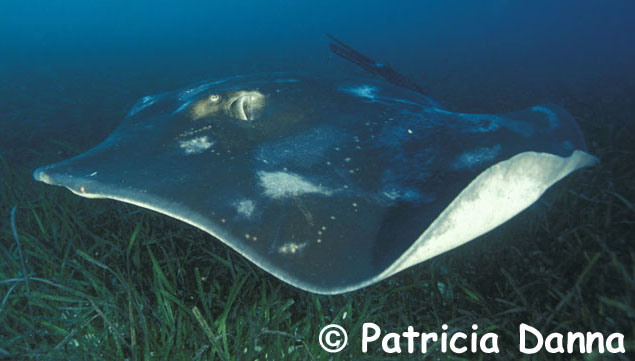| Dasyatidae (Stingrays), subfamily: Dasyatinae |
| 430 cm TL (male/unsexed) |
|
demersal; brackish; marine; depth range 0 - 476 m |
| Indo-West Pacific: antitropical; from southern Africa to New Zealand, and off Japan and Peter the Great Bay (eastern Russia). |
|
Dorsal spines (total): 0-0; Dorsal soft rays (total): 0-0. This species is huge, plain-coloured, with a disc broad and rhombic, belly with transverse groove, tail short tapering strongly before caudal sting, thorns when present are confined to tail before sting, pectoral fin with an oblique rows of white spots dorsally; disc width ca. 1.1-1.2 times its length, very thick trunk; narrowly-rounded pectoral-fin apex; short snout, obtuse with tip barely extended and anterior margins weakly convex; small eyes with orbit length and spiracle 2.0-2.2 in snout length; broad interorbital space, up to 4 times orbit length in adults; mouth often with 5-7 oral papillae, deep labial furrows, weakly convex lower jaw; very broadly skirt-shaped nasal curtain, its margin fringed; oblique oval nostrils; smooth skin, no derml denticles, with specimens > 45 cm WD having a row of spear-shaped or starry-based thorns and tubercles on mid-line of tail before the caudal sting and the tail beyond this is covered with sharp thornlets; very broad tail depressed at the base, often shorter that width disc, often with one caudal sting, its ventral fold is short but prominent (extending to just beyond tip of sting), its dorsal fold reduced to a hard ridge; pelvic fins are rather small with narrowly-rounded apices. Colour of upper surface uniformly greyish brown and darkest on tail tip and above the eye; white inside of spiracles, pores around side of head and diagonal row of pores on each side of anterior disc; white ventrally; disc margin and undersurface of tail dusky (Ref. 114953). |
| Occurs offshore, on the outer shelf and uppermost slope; sometimes close inshore (Ref. 5578), in very shallow ( 0 m) depths (Ref. 26346). Found on sandy bottoms, in bays, harbors, and near rocky reefs (Ref. 12951). Often in aggregations (Ref. 12951). Feeds on fishes, bivalves, squid, and crustaceans (Ref. 12951). Ovoviviparous (Ref. 50449). Reputed to be the largest stingray in the world weighing more than 350,000 g (Ref. 6871). Frequently raises its tail in a scorpion-like fashion when approached, but is considered more as inquisitive rather than aggressive (Ref. 6871). The barbed tail however can inflict a severe or potentially fatal wound (Ref. 6871). Sometimes caught by anglers (Ref. 5578). It is parasitised by the monogenean Heterocotyle tokoloshei in the gills (Ref. 124053) |
|
Least Concern (LC); Date assessed: 27 November 2020 Ref. (130435)
|
| venomous |
Source and more info: www.fishbase.org. For personal, classroom, and other internal use only. Not for publication.

